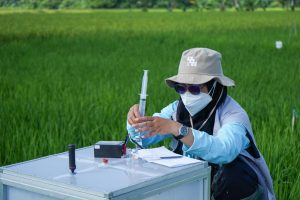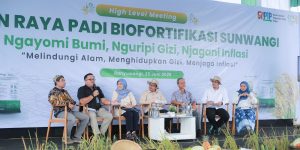Imagine you are in your favorite restaurant to celebrate Valentine’s Day with your beloved one. The atmosphere of a rainy afternoon tempts you to enjoy warm chocolate and you order a cup of coffee for him. A short time later, he comes and brings a bouquet of your favorite flowers. Then you spend a wonderful time together.
This romantic atmosphere would not have happened if there were no bees. Hot chocolate, a cup of coffee, and a bouquet of flowers that are symbols of affection depend on pollinators like bees. Currently, the bees population are declining. If the population continues to decline, then nutritious crops such as fruits, nuts, and many vegetables will no longer exist and there will only be staple foods such as rice, corn and potatoes which eventually resulting in an imbalanced diet.
Scientists have found that one of the causes of the decline in bee populations is the use of pesticides. Insecticides are pesticides used to control plant pests. However, when applied, insecticides cannot distinguish which pollinators or insects are good for plants, so insecticides can indirectly “kill” pollinators or good-natured insects.
Bees can be exposed to insecticides directly and indirectly. Direct exposure occurs when bees come into contact with insecticides. Bees directly exposed to insecticides do not return to the hive, which means that the insecticide is not transmitted to the colony.
Indirectly, bees are exposed to insecticides during their work, such as pollination, and then carry pollen and nectar in their bodies that has been exposed to insecticides. When the bees return to the hive, the insecticide exposure is transferred to other bees.
Contents
Bees (almost) extinct because of insecticide addiction?
Each insecticide consists of one or more chemicals, one of which acts as the active ingredient and the other as the inert ingredient. The active ingredient is the main element contained in insecticides used for pest control. Examples of active insecticide ingredients on the market are imidacloprid, acetamiprid, thiamethoxam, etc. Some of these active ingredients belong to the neonicotinoid class of active ingredients, a class of active ingredients that can be considered new.
Neonicotinoids are a class of active ingredients whose chemical content is close to Nicotine, which means if bees consume nectar contaminated with neonicotinoids, they become “addicted.” According to a study by the Imperial College London team, bees prefer food that contains neonicotinoids and will continue to seek out and then consume it more and more. This finding is not good news because the higher the exposure of bees to neonicotinoids, the greater the risk of a decline in bee populations. This finding is very interesting and has pushed PT Terra Agro Yields’s team to find out more about the wider effects of neonicotinoids on bees.
Inhibited Reproduction of Bees
Neonicotinoids inhibit the reproduction of bees. When the queen bee and drone (male bee) mate, sperm transfer occurs from the drone to the queen bee. The concentration of neonicotinoids in the insecticide causes the queen bee to carry fewer viable sperm and lay fewer fertilized eggs than usual. In addition, drones exposed to insecticides containing the active ingredients neonicotinoids and phenylpyrazoles can reduce sperm viability, resulting hamper fertilization of queens. The combination of drones and the exposed queen bee results in a genetically diverse workforce, which can affect division of labor and disease response.
Lates Articles :
- PT Terra Agro Yields Present RiceVitalize: A Bold Step Towards Healthier Food and Regenerative Farming
- Banyuwangi Launches the First Industrial-Scale Biofortified Rice Ecosystem in Indonesia: A Strategy to Strengthen Food Security and Control Inflation
- Banyuwangi Builds a Low-Carbon Future Through the Industrial-Scale Biofortified Rice Ecosystem
Lack of nutrients bees reduce colonial strength
One of the roles of the nurse bee is to provide royal jelly or nutrients to the queen bee and larvae during the growth phase. The nutrient-rich content of royal jelly is important for the development and physiology of the larvae.
Neonicotinoids affect the task of nurse bees. The active ingredient neonicotinoids in insecticides reduces the size of the hypopharyngeal and mandibular glands, so that the secretion of the jelly produced lacks the main protein. This can lead to a slowdown in larval growth and development and low body weight. In a further consequence, the colony becomes weaker, the lifespan of the bees decreases, and the bee population becomes smaller.
Affects Cognitive Functions of Bees
Cognitive functions are affected in bees exposed to insecticides containing neonicotinoid active ingredients. The bees have difficulty remembering spatial information, such as the location of food and predators. This reduced memory causes the bees to travel long routes in search of food, and they run out of energy to return to the hive. In addition, the bees no longer sensed predators as well, which resulted in the bees no longer avoiding and being afraid when they encountered their predators.
Lowering the Bees Immune System
Immunity of bees is weakened by contact with insecticides. Insecticides increase the number of bacteria, fungi, and virus pathogens in bees. The interaction between pathogens and insecticides increases the probability of disease complications in bees, increasing the potential for bee mortality. Insecticides also cause “immunosuppression,” or a weakening of the bees’ immune system, making them prone to pathogens.
Should we stop using insecticides with Neonicotinoid active ingredients?
The use of insecticides, especially those with neonicotinoid active ingredients, has an unfavorable effect on bees. Therefore, a solution must be found to avoid harming bees. Completely eliminating the use of insecticides would logically be the best way forward for the bee population, but could reduce crop yields and affect the food supply. The solution that could provide a middle way is to use a wiser method for insecticide use. PT Terra Agro Yields has summarized several methods for using insecticides that are friendly to pollinators like bees.
1. Alter Application Method
Insecticide application can reduce the risk of bee exposure to insecticides. Aerial application has the highest risk of bee death. Insecticides that float or move away from the target area can reach the hive directly. Using equipment that limits spraying to the target area can reduce the risk of bee exposure to insecticides.
2. Apply Insecticide in the evening
Bees have regular times for work and rest. Normally, bees leave the hive during the day to forage for food and return home when the sun begins to set. Spraying insecticides at the evening hours can reduces the risk of bee exposure.
3. Use Safer and Faster Degradable Insecticide
The use of safer insecticides that degrade faster is also important to reduce bee losses. Insecticide reductants can reduce insecticide doses by up to 50%. In addition, insecticide reductants degrade fast so they do not leave residues.
It turns out that the use of insecticides as pesticides can be useful, as summarized by the team of PT Terra Agro Yields. But do we realize that there are more than 1000 types of pesticides that can be used in and out of agriculture? Are insecticides the only type of pesticide causing the decline in bee populations? What about herbicides, which are the most commonly used worldwide?
About PT Terra Agro Yields
PT Terra Agro Yields is the first life science based company from Indonesia and currently the only one company that has innovation in the development of pesticide reduction products (pesticides reductant). Starting from this innovation, PT Terra Agro Yields is committed to helping agricultural businesses to create an agricultural practices that is sustainable, environmentally friendly, safe for users, and also cost-efficiency.
For more information visit : PT Terra Agro Yields









